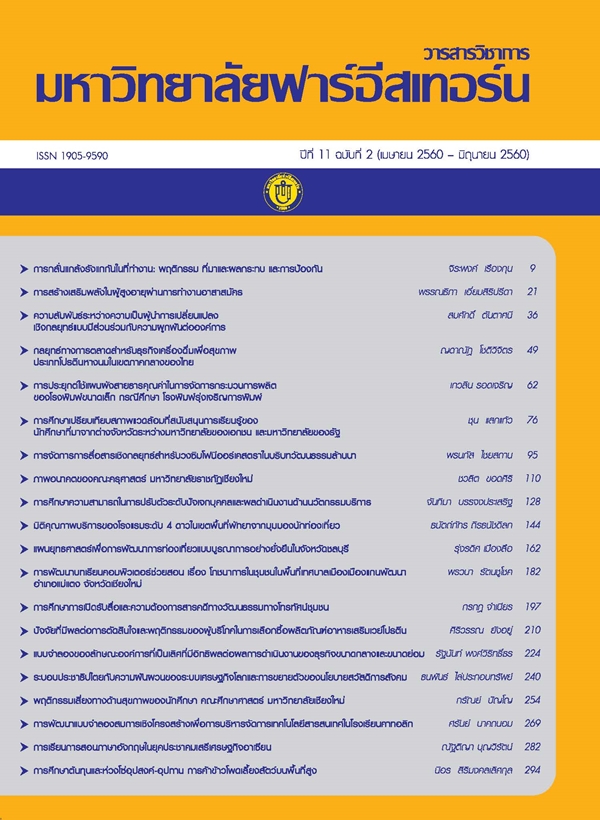กลยุทธ์ทางการตลาดสำหรับธุรกิจเครื่องดื่มเพื่อสุขภาพ ประเภทโปรตีนหางนมในเขตภาคกลางของไทย
Main Article Content
Abstract
การวิจัยนี้เป็นการวิจัยเชิงปริมาณ โดยมีวัตถุประสงค์เพื่อ 1) ศึกษาพฤติกรรมผู้บริโภค กลยุทธ์ทาง
การตลาด และประสิทธิผลของการใช้กลยุทธ์ทางการตลาด 2) ศึกษาความสัมพันธ์ระหว่างพฤติกรรมของ
ผู้บริโภค กลยุทธ์ทางการตลาดและประสิทธิผลการใช้กลยุทธ์ทางการตลาด 3) นำเสนอโมเดลกลยุทธ์ทาง
การตลาด ทำการเก็บรวบรวมข้อมูลด้วยแบบสอบถามที่ผ่านการทดสอบการหาค่าคุณภาพด้านค่าความตรง
และค่าความเชื่อมั่น โดยเก็บรวบรวมข้อมูลจากผู้บริโภคในเขตภาคกลางของประเทศไทยที่บริโภคเครื่องดื่ม
เพื่อสุขภาพประเภทโปรตีนหางนม จำนวน 400 คน สถิติที่ใช้ในการวิเคราะห์ข้อมูล ได้แก่ สถิติเชิงพรรณนา
ประกอบด้วย ค่าความถี่ ร้อยละ ค่าเฉลี่ยเลขคณิต และค่าส่วนเบี่ยงเบนมาตรฐาน สถิติที่ใช้ในการอนุมาน
สมมติฐาน ประกอบด้วย สถิติวิเคราะห์เส้นทางอิทธิพล และ สถิติการวิเคราะห์โมเดลสมการโครงสร้าง
ซึ่งจากผลการวิจัยตามวัตถุประสงค์ พบว่า 1) พฤติกรรมส่งผลต่อการบริโภคทั้งด้านแรงจูงใจ การเรียนรู้
การรับรู้และทัศนคติ และปัจจัยกลยุทธ์ทางการตลาด ที่ทำให้เกิดการซื้อในผู้บริโภคมากที่สุด คือ ปัจจัย
ด้านผลิตภัณฑ์ได้รับการรับรองมาตรฐานและมีคุณค่าทางโภชนาการ และการวัดประสิทธิผลของการใช้กลยุทธ์
ทางการตลาด ต้องพิจารณาถึงความภักดีของผู้บริโภค 2) พฤติกรรมผู้บริโภคมีอิทธิพลทั้งทางตรงและ
ทางอ้อมต่อประสิทธิผลของการใช้กลยุทธ์ทางการตลาด และกลยุทธ์ทางการตลาดมีอิทธิพลทางตรงต่อ
ประสิทธิผลของการใช้กลยุทธ์ทางการตลาด 3) โมเดลสมการโครงสร้างมีความสอดคล้องกับข้อมูลเชิงประจักษ์
ในเกณฑ์ดี โดยมีค่า = 55.646, df = 31, P-value = 0.093, RMSEA = 0.034, GFI = 0.96 และ AGFI =
0.94 โดยกลยุทธ์ทางการตลาดที่ดีจะทำให้ประสิทธิผลของการใช้กลยุทธ์ทางการตลาดดีขึ้น
This research was a quantitative research with an objective to 1) Study the consumer
behavior, marketing strategy and strategic effectiveness 2) Study a relationship between
consumer behavior, marketing strategy and strategic effectiveness 3) Propose a model of marketing
strategy. Data collection was conducted by using a questionnaire that its validity and reliability were
tested. Population was whey protein drink’s consumers who live in the central region of Thailand.
The sample size in this study was 400 samples. Statistics analysis was descriptive statistics which
including frequency, percentage and arithmetic mean, and standard deviation. According to the
inferential statistics, there were path analysis and structural equation modeling. Results of research
objectives found that 1) Consumer behavior affected on motivations, learnings, perceptions and
attitudes. As a strategic marketing, the most influence factors is the product strategy that the
product was certified and had a high nutrition value. For measuring the marketing effectiveness
must consider consumer loyalty. 2) Consumer behavior both influenced directly and indirectly of
the marketing strategic effectiveness and marketing strategies influenced directly on the effectiveness
of using marketing strategies. 3) Structural equation modeling revealed that corresponded to the
empirical evidence in a good level with = 55.646, df = 31, P-value = 0.093, RMSEA = 0.034,
GFI = 0.96 และ AGFI = 0.94. A good marketing strategy improved more the effectiveness of using
strategy.
Article Details
1. Any views and comments in the Journal of Social Innovation and Lifelong Learning are the authors’ views. The editorial staff have not to agree with those views and it is not considered as the editorial’s responsibility.
2. The responsibility of content and draft check of each article belongs to each author. In case, there is any lawsuit about copyright infringement. It is considered as the authors’ sole responsibility.
3. The article copyright belonging to the authors and The Far Eastern University are copyrighted legally. Republication must be received direct permission from the authors and The Far Eastern University in written form.
References
กิ่งกนก บุนนาค. (2553). พฤติกรรมผู้บริโภคที่มีอิทธิพลต่อกระบวนการตัดสินใจซื้อน้ำดื่มเพิ่มคุณค่าเพื่อสุขภาพ.วิทยานิพนธ์บริหารธุรกิจมหาบัณฑิต สาขาบริหารธุรกิจมหาวิทยาลัยเทคโนโลยีราชมงคลธัญบุรี.
วรุณกาญจน์ สุริยะ. (2556). พฤติกรรมและปัจจัยส่วนประสมทางการตลาดที่มีต่อการตัดสินใจซื้อผลิตภัณฑ์เครื่องดื่มเพื่อสุขภาพเวย์โปรตีนของกลุ่มผู้ออกกำลังกายในเขตอำเภอเมืองจังหวัดลำปาง.วิทยานิพนธ์บริหารธุรกิจมหาบัณฑิต สาขาบริหารธุรกิจ มหาวิทยาลัยเนชั่น.
ศิริวรรณ เสรีรัตน์ และคณะ. (2552). การบริหารการตลาดยุคใหม่ฉบับปรับปรุงใหม่ปี 2552. กรุงเทพมหานคร : บริษัท ธรรมสาร จำกัด.
อดุลย์ จาตุรงคกุล และดลยา จาตุรงคกุล. (2550). พฤติกรรมผู้บริโภค. พิมพ์ครั้งที่ 2. กรุงเทพมหานคร: บริษัท ธรรมสาร จำกัด.
Affertsholt, T. (2009). International whey market overview. 3A Business Consulting. 1: .5-13.
Asiraphot, V. and Waleetorncheepsawat, W. (2009). A study of attitude towards energy drinks in attitude towards energy drinks in Thailand. Master Thesis in Business, Graduate School, Malardalen University.
Bennet, A.R. (1997). The Five vs – a buyer’s perspective of the marketing mix. Marketing Intelligence & Planning. 15: 151-156.
Kalcheva, V.D. and Weitz,B.A. (2006). When should retailer create an exciting environment? Journal of Marketing, 70: .107-118.
Kotler, P.T. and Keller, K.L. (2006). Marketing Management. 12th ed. New Jersey: Prentice Hall.
Kotler,P.T. (2000). Marketing Management. Millennium ed. New Jersey: Prentice Hall.
Lovelock, C. and Wirtz, J. (2007). Service Marketing. 6th ed. New Jersey: Prentice Hall.
Schiffman, L. and Kanuk,L . (2009). Consumer Behavior. 8th ed. New Jersey: Prentice Hall.
Schultz, D.E. (2005). The loyalty paradox. Marketing management. 14: 10-11.
Taylor,S.A., Celuch, K. and Goodwin,S. (2004). The importance of brand equity to customer loyalty. Journal of Product & Brand Management. 13: 217-227.
Thompson, M. Newman, F. and Liu, M. (2011). The impact of culture on brand loyalty: A study of the young affluent Chinese. Journal of Business Research. 67: .2437-2446.
Wulansari, D.C. (2011). The marketing strategy of jackfruit seed extract health drinks. Journal of Business & Industrial Marketing.

